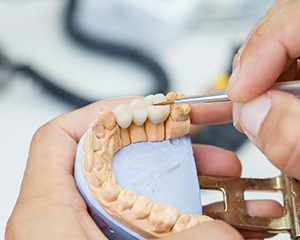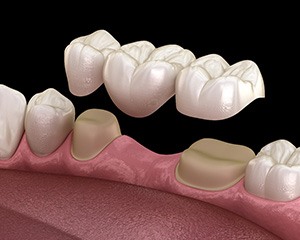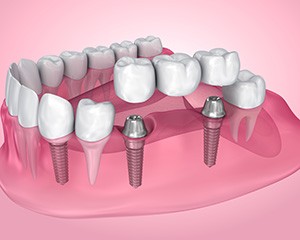Dental Bridges – Milwaukee, WI
Filling Gaps from Multiple Missing Teeth

As you may know, just losing one of your teeth is often bad enough. Missing a tooth can ruin your good looks and oral health, causing a notable decline in your quality of life. It’s only natural that losing several adjacent teeth is even worse – for you and your smile. That said, there’s good news: our practice can fix the second problem with its dental bridges in Milwaukee. Find out about them by reading below, or make an appointment with us.
What is a Dental Bridge?

Like dental implants or dentures, a dental bridge is a prosthetic oral device. Using materials fused to either side of an artificial tooth, it can replace one to four teeth at once. That setup lets it “bridge” fairly large gaps left by tooth loss.
Those who’ve lost adjacent teeth are the best candidates for dental bridges. These patients can fully restore their smiles with one treatment, so they stand to benefit the most. Otherwise, qualifying for treatment isn’t a hard or complex process. Most adults can get dental bridges if their gums and jaw are healthy.
The Types of Dental Bridges

Before the dental bridge treatment, Dr. Franzen will closely examine your smile. He’ll use the findings from this exam to draft a custom treatment plan for you. During that second step, he and our team will likely suggest one of the following dental bridges:
Traditional Dental Bridge

A traditional dental bridge (per its name) is the kind that’s been used often for the past few decades. In general, it’s made of dental crowns fused to either side of a pontic (i.e., an artificial tooth). That means the device uses your nearby natural teeth or “abutments” to stay in place.
Between the two types, the traditional dental bridge is less costly. Its features make it less expensive than implant-based models, though it does remove some enamel during placement.
Implant Bridge

Unlike a regular one, an implant bridge uses dental implants – small metal posts placed in your jaw. These posts slowly fuse with your jawbone to secure and stabilize the final restoration. In other words, the resulting bridge won’t fall or come loose like other replacement teeth can.
An implant bridge doesn’t use dental crowns, so it can’t alter existing teeth. Our team won’t have to prep “abutments” to place the device. Still, this feature does make the bridge pricier.
The Benefits of Getting a Dental Bridge

You’ll enjoy many perks once you have a dental bridge. These include benefits like:
- Enhanced Oral Health – Since it bridges your smile’s gaps, a dental bridge reduces the spread of harmful bacteria in your mouth. The device also keeps your other teeth from tilting.
- A Beautiful Smile – A modern dental bridge uses teeth made of porcelain, so it’ll blend seamlessly with your smile.
- Much Easier Eating – With the new teeth from your dental bridge, you can chew tough foods more easily.
- Long-Lasting Results – A typical dental bridge lasts 5-15 years, and a well-maintained one can work for 20 years or more.
In the end, a dental bridge has a lot to offer your gapped grin. Consider whether to get one and consult us about a possible consultation.
